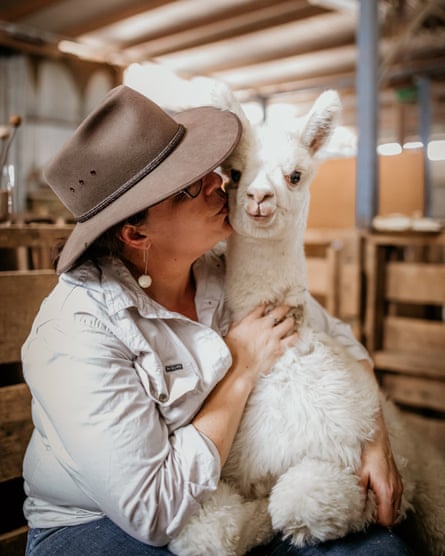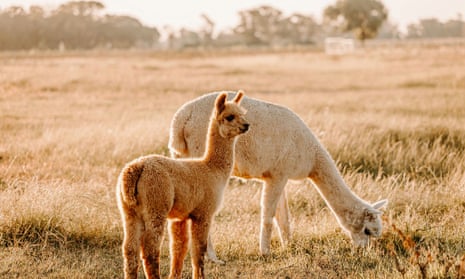Australia has the second-largest alpaca herd in the world behind Peru, but most still view the leggy camelids as the stuff of hobby farms.
Alpacas were introduced to Australia about 25 years ago and were initially primarily used as livestock guardians. Paddocked with sheep, they will kick and chase dogs and foxes that get too close to the lambs.
There were 350,000 alpacas in Australia in 2021, according to a report by Agrifutures Australia, and, after a baby boom fuelled by ideal breeding conditions, the herd is on track to reach 400,000.
Amee Dennis, who has 110 alpacas at her family farm in the central west of New South Wales, is among those who see the animals as a secondary income source. “We got our first alpacas close to five years ago, purely as guards for lambs,” Dennis said.
“We did not know a single thing about an alpaca but we figured it [had] to be easier than sitting out every night with a spotlight trying to deal with the problem that way.”
Now Dennis uses the alpaca fleeces to make fibre art. The farm, Quinton Park, offers tourists high tea with the alpacas. Visitors can also sponsor an animal.
But most of their income comes from selling the fibre. “Even though the tourism side of our business has absolutely been growing and we’ve worked really hard to do that over the last couple of years, where we started was products and fibre, and that’s still where our main income comes from as far as the alpacas are concerned.”

Most alpaca farms make their money from fibre. About 250,000 alpacas are used to produce fibre for sale, the Agrifutures report said, with each yielding about 5kg a year, suggesting an annual farmgate value of about $13.5m. The industry is worth $19.5m.
The report added that the farmgate value had the potential to double if there was improved grower education and awareness of fibre market needs. But with most alpaca farmers being hobbyists or using their herd as a secondary income, it warned that growth may be slow.
Lee Sadler, the vice-president of the Australian Alpaca Association, said most of their members had only modest herds of alpaca, and were not drawing a full-time income. “[Full-time alpaca farmers] are in the tens, not in the hundreds,” she said.
“They have sufficient land, sufficient land holdings and sufficient numbers of alpacas to make a very successful enterprise. But a lot of people are on small land holdings, and they’ve chosen that as a lifestyle to accompany their other full-time endeavours.
after newsletter promotion
“That doesn’t mean that there’s not the opportunity for people to be very successful in a larger alpaca enterprise.”
Alpaca farming is new in Australia and large farms are often multigenerational. It will take time to build up to bigger enterprises, Sadler said.
“Most of us have chosen to be involved,” she said. “So we’ve stepped from something else into alpacas, either in a part-time or a full-time capacity.”
Dennis said while alpacas were becoming common in Australia, the industry was not quite in the position for most to use it as a sole income.
“We have this massive herd now and it’s so cool that we’re sitting in that position, but we’re still not in a position where we can rely on alpacas,” she said. “Part of that is education about the quality of the fibre and the quality of the products that you can produce. I think we’ve still got a bit of work to do for that.”
Emily Middleton is a journalist in Gilgandra, NSW
Join the Rural Network group on Facebook to be part of the community
